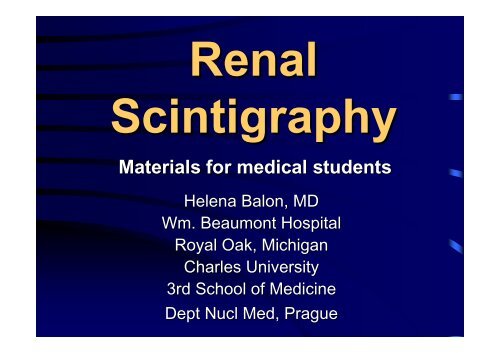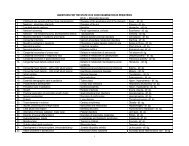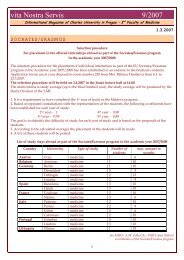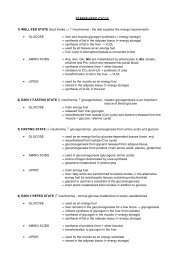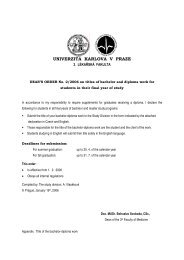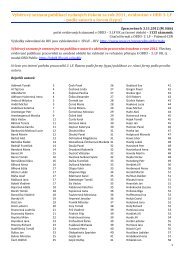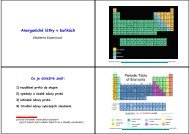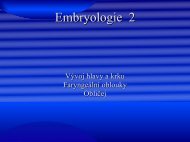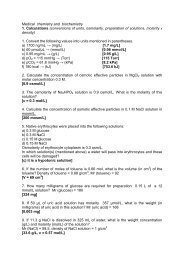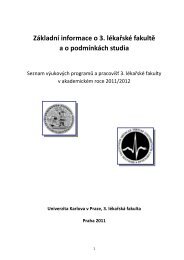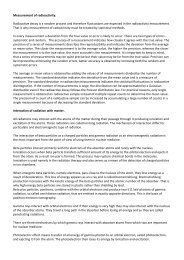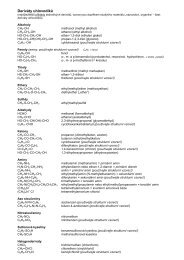Diuretic Renal Scan Interpretation
Diuretic Renal Scan Interpretation
Diuretic Renal Scan Interpretation
Create successful ePaper yourself
Turn your PDF publications into a flip-book with our unique Google optimized e-Paper software.
<strong>Renal</strong><br />
Scintigraphy<br />
Materials for medical students<br />
Helena Balon, , MD<br />
Wm. Beaumont Hospital<br />
Royal Oak, Michigan<br />
Charles University<br />
3rd School of Medicine<br />
Dept Nucl Med, Prague
Indications<br />
Evaluation of:<br />
<strong>Renal</strong> perfusion and function<br />
Obstruction (Lasix(<br />
renal scan)<br />
Renovascular<br />
HTN (Captopril(<br />
renal scan)<br />
Infection (renal morphology scan)<br />
Pre-surgical<br />
quantitation (nephrectomy)<br />
<strong>Renal</strong> transplant<br />
Congenital anomalies, masses<br />
(renal morphology scan)
<strong>Renal</strong> Function<br />
Blood flow - 20% cardiac output to kidneys<br />
(1200 ml/min blood, 600 ml/min plasma)<br />
Filtration<br />
- 20% renal plasma flow filtered by<br />
glomeruli (120 ml/min, 170 L/d)<br />
Tubular secretion<br />
Tubular<br />
reabsorption (1% ultrafiltrate - urine)<br />
Endocrine<br />
functions
<strong>Renal</strong> Radiotracers<br />
Excretion Mechanisms<br />
GF TS TF<br />
Tc-99m DTPA >95%<br />
Tc-99m MAG3
<strong>Renal</strong><br />
Radiopharmaceuticals<br />
Extract. fraction<br />
Clearance<br />
Tc-99m DTPA 20% 100-120 ml/min<br />
Tc-99m MAG3 40-50% ~ 300 ml/min<br />
I-131 OIH ~100% 500-600 ml/min
<strong>Renal</strong> Radiopharmaceuticals<br />
Dosimetry<br />
DTPA MAG3 GHA DMSA I-131OIH<br />
rad/10 mCi<br />
rad/5mCi rad/300µCi<br />
Kidney 0.2 0.15 1.6 3.5 0.01<br />
Bladder 2.8 5.1 2.7 0.3 0.3<br />
EDE (rem) 0.3 0.4 0.4 0.3 0.03
Choosing <strong>Renal</strong><br />
Radiotracers<br />
Clin. Question<br />
Agent<br />
Perfusion<br />
Morphology<br />
Obstruction<br />
Relative function<br />
MAG3, DTPA, GHA<br />
DMSA, GHA<br />
MAG3, DTPA, OIH<br />
All<br />
GFR quantitation I-125<br />
iothalamate,<br />
Cr-51 EDTA, DTPA<br />
ERPF quantitation<br />
MAG3, OIH
Basic <strong>Renal</strong> <strong>Scan</strong><br />
Procedure
Basic <strong>Renal</strong> Scintigraphy<br />
Patient Preparation<br />
Patient must be well hydrated<br />
Give 5-105<br />
ml/kg water (2-4 4 cups)<br />
30-60 min. pre-injection<br />
Can measure U - specific gravity (
Basic <strong>Renal</strong> Scintigraphy<br />
Acquisition<br />
Supine position preferred<br />
Do not inject by straight stick<br />
Flow (angiogram) : 2-32<br />
3 sec / fr x 1 min<br />
Dynamic: 15-30 sec / frame x 20-30 min<br />
(display @ 1-31<br />
3 min/frame)
Basic <strong>Renal</strong> Scintigraphy<br />
Acquisition (cont’d)<br />
Obtain a 30-60 sec. image over injection site<br />
@ end of study<br />
if infiltration >0.5% dose<br />
clearance<br />
do not report<br />
Obtain post-void supine image of kidneys<br />
@ end of study<br />
Taylor, SeminNM 4/99:102-127
International Consensus<br />
Committee Recommendations for<br />
Tracer: MAG3, (DTPA)<br />
Basic Renogram<br />
Dose: 2 - 5 mCi adult, minimum 0.5 mCi peds<br />
Pt. position: supine (motion, depth issues)<br />
Include bladder, heart<br />
Collimator: LEAP<br />
Image over injection site<br />
Int’l Consens. . Comm.<br />
Semin NM ‘99:146-159159
DTPA normal
DTPA normal
Relative (split) function<br />
ROI’s
Relative uptake<br />
Contribution of each kidney to the total fct<br />
net cts in Lt ROI<br />
--------------------------------------- x 100%<br />
net cts Lt + net cts Rt ROI<br />
% Lt kid = ---------------------------------------<br />
Normal<br />
50/50 - 56/44<br />
Borderline<br />
57/43 - 59/41<br />
Abnormal<br />
> 60/40<br />
Taylor, SeminNM Apr 99
Time to peak<br />
Basic <strong>Renal</strong> Scintigraphy<br />
Processing<br />
Best from cortical ROI<br />
Normal < 5 min<br />
Residual Cortical Activity (RCA 20 or 30<br />
Ratio of cts<br />
Use cortical ROI<br />
20 or 30 )<br />
cts @ 20 or 30 min / peak cts<br />
Normal RCA 20 for MAG3 < 0.3<br />
Residual Urine Volume<br />
(post-void<br />
cts x void. vol) ÷ (pre-void<br />
cts - post void cts)
DTPA flow + scan<br />
GFR = 29 ml/’<br />
Creat = 2.0<br />
L= 33%<br />
R= 67%
<strong>Renal</strong> artery occlusion
Rt renal infarct
Renogram Phases<br />
I.<br />
Vascular phase (flow study):Ao<br />
Ao-to-Kid ~ 3” 3<br />
II.<br />
Parenchymal phase (kidney-to<br />
III.<br />
Washout (excretory) phase<br />
to-bkg):<br />
peak < 5’ 5<br />
): Tpeak
Renogram curves
Evaluation of<br />
Hydronephrosis<br />
<strong>Diuretic</strong> (Lasix(<br />
Lasix) ) <strong>Renal</strong> <strong>Scan</strong>
Obstruction<br />
Obstruction to urine outflow leads to<br />
obstructive uropathy<br />
(hydronephrosis, hydroureter)<br />
and<br />
may lead to obstructive nephropathy<br />
(loss of renal function)
<strong>Diuretic</strong> <strong>Renal</strong> <strong>Scan</strong><br />
Principle<br />
Hydronephrosis<br />
- tracer pooling in dilated<br />
renal pelvis<br />
Lasix<br />
induces increased urine flow<br />
If obstructed >>> will not wash out<br />
If dilated, non-obstructed obstructed >>> will wash out<br />
Can<br />
quantitate rate of washout (T 1/2<br />
1/2 )
<strong>Diuretic</strong> <strong>Renal</strong> <strong>Scan</strong><br />
Indications<br />
Evaluate functional significance of<br />
hydronephrosis<br />
Determine need for surgery<br />
obstructive<br />
hydronephrosis - surgical Rx<br />
non-obstructive<br />
obstructive hydronephrosis - medical Rx<br />
Monitor effect of therapy
<strong>Diuretic</strong> <strong>Renal</strong> <strong>Scan</strong><br />
Requirements<br />
Rapidly cleared tracer<br />
Well hydrated patient<br />
Good renal function
Pt. preparation:<br />
prehydration<br />
<strong>Diuretic</strong> <strong>Renal</strong> <strong>Scan</strong><br />
Procedure<br />
adults - oral or 360ml/m 2 iv over 30’<br />
peds - 10-15 15 ml/kg D5 0.3-0.45%NS<br />
0.45%NS<br />
void before injection<br />
bladder catheterization
<strong>Diuretic</strong> <strong>Renal</strong> <strong>Scan</strong><br />
Procedure (cont’d)<br />
Tracers:<br />
Tc-99m MAG3 5-105<br />
mCi<br />
(preferred over DTPA)<br />
Acquisition: supine until pelvis full<br />
(can switch to sitting post- Lasix)<br />
Flow (angiogram) : 2-32<br />
3 sec / fr x 1 min<br />
Dynamic:<br />
15-30 sec / frame x 20-30 min
<strong>Diuretic</strong> <strong>Renal</strong> <strong>Scan</strong><br />
Procedure (cont’d)<br />
Void before Lasix<br />
Lasix:<br />
40mg adult, 1mg/kg child iv<br />
@ ~10-20 min (when pelvis full)<br />
or @ -15min (“F-15(<br />
15” method)<br />
Acquisition for 30 min post Lasix<br />
Assess adequacy of diuresis<br />
Measure voided volume<br />
Adults produce ~200-300 ml urine post-Lasix
<strong>Diuretic</strong> <strong>Renal</strong> <strong>Scan</strong><br />
Procedure (cont’d)<br />
Don’t t give Lasix if<br />
Collecting system still filling<br />
Collecting system not full by 60 min<br />
Collecting system drains spontaneously<br />
Poor<br />
ipsilateral fct (< 20%)
pre-Lasix
post-Lasix
No UPJ obstruction<br />
T1/2<br />
R = 6’ 6<br />
L = 2’ 2
Post-Lasix<br />
curve
Pre-Lasix<br />
10 y/o M
Post-Lasix
Rt UPJ obstruction<br />
T1/2<br />
R = N/A<br />
F/U - nephrostomy tube placed
Lt hydronephrosis<br />
3-wk old baby<br />
3164897
Lt UPJ obstruction<br />
3164897
Rt UPJ obstruction<br />
T1/2<br />
R = N/A<br />
F/U - nephrostomy tube placed
Lt UPJ obstruction<br />
3164897
ROI placement<br />
<strong>Diuretic</strong> <strong>Renal</strong> <strong>Scan</strong><br />
Processing<br />
around whole kidney or<br />
around dilated renal collecting system<br />
T/A curve<br />
T 1/2<br />
from<br />
Lasix injection vs. from diuretic response<br />
linear<br />
vs. . exponential fit of washout curve
<strong>Diuretic</strong> <strong>Renal</strong> <strong>Scan</strong><br />
Washout<br />
(diuretic response)<br />
T1/2<br />
time required for 50% tracer to leave<br />
the dilated unit<br />
i.e. time required for activity to fall<br />
to 50% of peak
T washout<br />
1/2 cts<br />
100%<br />
50%<br />
T 1/2 min
T value<br />
1/2 Variables influencing T1/2T<br />
value:<br />
Tracer<br />
State of hydration<br />
Volume of dilated pelvis<br />
Bladder catheterization<br />
Dose of Lasix<br />
<strong>Renal</strong> function (response to Lasix)<br />
ROI (kidney vs. pelvis)<br />
T 1/2 calculation (from inj. . vs. response, curve fit)
Normal<br />
Obstructed<br />
T1/2<br />
< 10 min<br />
> 20 min<br />
Indeterminate<br />
10 - 20 min<br />
Best to obtain own normals for each<br />
institution, depending on protocol used
<strong>Diuretic</strong> <strong>Renal</strong> <strong>Scan</strong><br />
<strong>Interpretation</strong><br />
Interpret whole study, not T alone<br />
1/2 Visual (dynamic images)<br />
Washout curve shape (concave vs. convex)<br />
T 1/2
<strong>Diuretic</strong> <strong>Renal</strong> <strong>Scan</strong><br />
Pitfalls<br />
False positive for obstruction<br />
Distended bladder<br />
Gross<br />
hydronephrosis<br />
T(transit time) = V (volume) ÷ F (flow)<br />
Poorly functioning / immature kidney<br />
Dehydration<br />
False negative<br />
Low grade obstruction<br />
Poorly functioning / immature kidney
Effect of catheterization (1)<br />
full bladder,<br />
no catheter
Effect of catheterization (2)<br />
with catheter<br />
in bladder
Effect of catheterization (3)<br />
without catheter<br />
with catheter
“F F minus 15”<br />
<strong>Diuretic</strong> Renogram<br />
Furosemide<br />
(Lasix)) injected 15 min before<br />
radiopharmaceutical<br />
Rationale: kidney in maximal diuresis,<br />
under maximal stress<br />
Some<br />
equivocals will become clearly<br />
positive, some clearly negative<br />
English, Br JUrol 1987:10-14<br />
Upsdell, Br JUrol 1992:126-132
Evaluation of<br />
Renovascular<br />
Hypertension<br />
Captopril <strong>Renal</strong> <strong>Scan</strong><br />
(ACEI Renography)
Renovascular Disease<br />
<strong>Renal</strong> artery stenosis (RAS)<br />
Ischemic nephropathy<br />
Renovascular<br />
hypertension (RVH)<br />
RAS ≠ RVH
Renovascular<br />
Hypertension<br />
Caused by renal hypoperfusion<br />
Atherosclerosis<br />
Fibromuscular<br />
dysplasia<br />
Mediated by renin - AT - aldosterone system<br />
Potentially curable by renal revascularization
Prevalence<br />
Renovascular<br />
Hypertension<br />
50y<br />
Severe HTN resistant to medical Rx<br />
Unexplained or post-ACEI impairment in ren fct<br />
HTN + abdominal bruits<br />
If these present - moderate risk of RVH (20-30%)
Renin-Angiotensin<br />
System<br />
Angiotensinogen<br />
Angiotensin I<br />
Angiotensin II<br />
Captopril<br />
Renin<br />
ACE<br />
RAS<br />
Aldosterone<br />
Vasoconstriction<br />
HTN
Effect of RAS on GFR
Diagnosis of RAS<br />
Gold std: angiography<br />
Initial non-invasive tests:<br />
ACEI<br />
renography<br />
Duplex<br />
sonography<br />
Other tests:<br />
MRA<br />
- insensitive for distal / segmental RAS<br />
Captopril<br />
test (PRA post-C.)<br />
- low sensitivity<br />
<strong>Renal</strong> vein renin levels
ACEI Renography
Off ACEI & ATII receptor blockers x 3-73<br />
7 days<br />
Off diuretics x 5-7d5<br />
No solid food x 4 hrs<br />
Patient well hydrated<br />
10 ml/kg water 30-60 min pre- and during test<br />
ACEI<br />
Captopril 25-50 50 mg po (crushed), 1 hr pre-scan<br />
Enalaprilat 40 µg/kg iv (2.5 mg max), 15 min pre-scan<br />
Monitor BP q 15 min<br />
ACEI Renography<br />
Patient Preparation
ACEI Renography<br />
Procedure<br />
Tracer:<br />
Protocol:<br />
Tc-99m MAG3 (or DTPA)<br />
1 day vs. . 2 day test<br />
1 1 day test: baseline scan (1-2 mCi) ) followed by<br />
post-Capto<br />
scan (8-10<br />
mCi)<br />
2 2 day test: post-Capto<br />
scan,<br />
only if abnormal >> baseline<br />
Acquisition:<br />
flow & dynamic x 20-30 min.
ACEI Renography<br />
Processing<br />
Relative renal uptake (bkg(<br />
corrected)<br />
Time to peak (T(<br />
p ) - from cortical ROI<br />
normal < 5 min<br />
RCA<br />
20 (20 min/peak ratio) - from cortical ROI<br />
normal < 0.3
ACEI Renography<br />
Grading renogram curves
ACEI Renography<br />
Diagnostic Criteria<br />
MAG3:<br />
ipsilateral parenchymal retention<br />
p.C.<br />
change in renogram curve by ≥ 1 grade<br />
RCA 20 increase by ≥ 15% (e.g. from 30% to 45%)<br />
T p increase by ≥ 2 min or 40% (e.g. from 5 to 7’) 7<br />
DTPA:<br />
ipsilateral decreased uptake<br />
Decrease in relative uptake ≥ 10%<br />
(e.g.from 50/50 to 40/60), change of 5-9% 5<br />
- intermediate<br />
change in renogram curve by ≥ 2 grades<br />
Consens. report JNM ‘96:1876<br />
Semin NM 4/99:128-145
ACEI Renography<br />
<strong>Interpretation</strong><br />
High probability RVH (>90%)<br />
Marked C-induced C<br />
change<br />
Low probability RVH (
Captopril <strong>Renal</strong> <strong>Scan</strong><br />
MAG 3
Captopril <strong>Renal</strong> <strong>Scan</strong> MAG3
Captopril <strong>Renal</strong> <strong>Scan</strong><br />
MAG 3
Captopril <strong>Renal</strong> <strong>Scan</strong><br />
MAG 3
ACEI Renography<br />
In normal renal function - sens/spec ~ 90%<br />
In poor renal fct / ischemic nephropathy,<br />
ACEI renography often indeterminate<br />
>>> do MRA, Duplex US, angio
Evaluation of <strong>Renal</strong><br />
Infection<br />
<strong>Renal</strong> Morphology <strong>Scan</strong><br />
(<strong>Renal</strong> Cortical<br />
Scintigraphy)
UTI<br />
VUR<br />
risk factor for PN,<br />
not all pts w PN have VUR<br />
PN may lead to scarring >>> ESRD, HTN<br />
early<br />
Dx and Rx necessary<br />
Clinical & laboratory Dx of renal involvement<br />
in UTI unreliable
<strong>Renal</strong> Cortical Scintigraphy<br />
Indications<br />
Determine involvement of upper tract<br />
(kidney) in acute UTI (acute pyelonephritis)<br />
Detect cortical scarring (chronic pyelonephr.)<br />
Follow-up post Rx
Tracers<br />
<strong>Renal</strong> Cortical Scintigraphy<br />
Tc-99m DMSA<br />
Tc-99m GHA<br />
Acquisition<br />
Procedure<br />
2-4 4 hrs post-injection<br />
parallel hole posterior<br />
pinhole post. + post. oblique (or SPECT)<br />
Processing: relative fct
Acute PN<br />
<strong>Renal</strong> Cortical Scintigraphy<br />
<strong>Interpretation</strong><br />
single or multiple “cold” defects<br />
renal contour not distorted<br />
diffuse decreased uptake<br />
diffusely enlarged kidney or focal bulging<br />
Chronic PN<br />
volume loss, cortical thinning<br />
defects with sharp edges<br />
Differentiation of AcPN vs. ChPN unreliable
<strong>Renal</strong> Cortical Scintigraphy<br />
“Cold Defect “<br />
Acute or chronic PN<br />
Hydronephrosis<br />
Cyst<br />
Tumors<br />
Trauma (contusion, laceration, rupture,<br />
hematoma)<br />
Infarct
DMSA<br />
parallel hole collimator
Normal DMSA<br />
pinhole<br />
LPO RPO
DMSA
Acute pyelonephritis<br />
DMSA<br />
post L<br />
post R<br />
LEAP<br />
LPO pinhole<br />
RPO
<strong>Renal</strong> Cortical Scintigraphy<br />
Congenital Anomalies<br />
Agenesis<br />
Ectopy<br />
Fusion<br />
(horseshoe, crossed fused ectopia)<br />
Polycystic<br />
kidney<br />
Multicystic<br />
dysplastic kidney<br />
Pseudomasses<br />
(fetal<br />
column of Bertin)<br />
(fetal lobulation, hypertrophic
DMSA<br />
horseshoe kidney<br />
parallel<br />
pinhole
DMSA<br />
Lt Agenesis<br />
parallel
GHA<br />
Crossed ectopia<br />
74%<br />
26%
Radionuclide<br />
Cystogram
Indications<br />
Evaluation of children with recurrent UTI<br />
30-50% have VUR<br />
F/U after initial VCUG<br />
Assess effect of therapy / surgery<br />
Screening of siblings of reflux pts.
Methods<br />
Direct<br />
Tc-99m S.C. or<br />
TcO4<br />
Advant.<br />
via Foley<br />
can do at any age<br />
Disadv.<br />
VUR during filling<br />
catheterization<br />
Indirect<br />
Tc-99m DTPA or<br />
Tc-99m MAG3<br />
i.v.<br />
no catheter<br />
info on kidneys<br />
need pt<br />
cooperation<br />
need good renal<br />
fct
Direct Cystography<br />
1 mCi S.C. in saline via Foley<br />
Fill bladder until reversal of flow<br />
(bladder capacity = (age+2) x 30<br />
Continuous imaging during filling &<br />
voiding<br />
Post void image<br />
Record<br />
volume instilled<br />
volume voided<br />
pre- and post- void cts
RN Cystogram vs.<br />
Advantages<br />
VCUG<br />
Disadvantages<br />
Lower radiation<br />
dose<br />
(5 vs 300 mrad to<br />
ovary)<br />
Smaller amount of<br />
reflux detectable<br />
Quantitation<br />
of<br />
post-void residual<br />
volume<br />
Cannot detect distal<br />
ureteral reflux<br />
No anatomic detail<br />
Grading difficult
Normal cystogram<br />
filling voiding post-void
A<br />
VUR - filling phase
VUR - voiding phase &<br />
post-void<br />
B
Post void residual<br />
volume<br />
RV =<br />
voided vol x post-void<br />
cts<br />
pre-void<br />
cts - post void cts
Reflux nephropathy<br />
16% 84%


